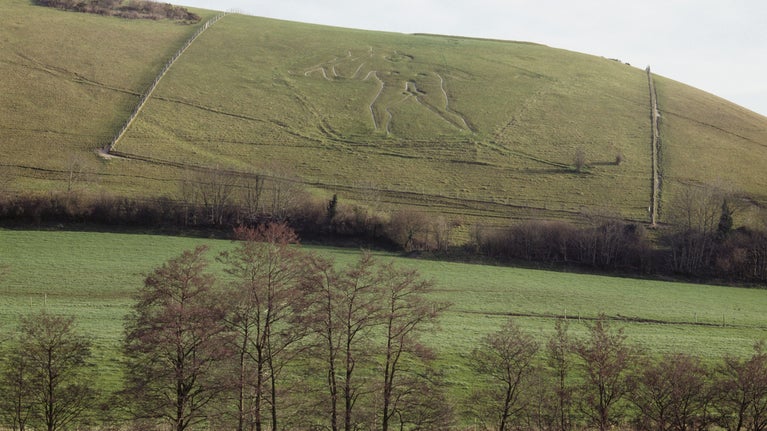Caring for the Cerne Giant
- Published:
- 09 June 2025

Visitors often come to Cerne Abbas hoping to catch a clear view of the Giant on the hillside, but at times, he can look faint or be hard to spot. That isn’t an oversight and he hasn’t been forgotten. What you’re seeing is part of the care he receives.
Why the Giant sometimes disappears
The Cerne Giant isn’t painted on or fixed in stone or cement like some other hill figures. He’s made from chalk cut into the living land. Grass grows, rain falls and seeds scatter. Through all seasons, we look after both the Giant and the hill he calls home.
His apperance changes from hour to hour depending on the light and the position of the sun. In some months the chalk looks bright and clear. At other times, summer growth softens his shape. This isn’t new. In 1925 Thomas Hardy wrote that the Giant was “always green”, not stark white like other chalk figures. A photograph from 1911 shows the same thing. The Giant fades, then reappears. That has always been his rhythm.
Balancing nature and care
We take great care in managing this cycle. The hill is a Site of Special Scientific Interest (SSSI), rich in wild plants, insects and historic features. We have to protect what grows and lives here, while also looking after the Giant. That’s why we don’t use regular mowing or heavy equipment, as it could easily damage thin chalk turf.

Grazing with purpose
Twice a year, a local farmer brings up a small group of sheep. These ewes graze the grass and thin out the thickest patches, which helps protect the smaller plants. Their small mouths help them eat selectively. Their light step means they don’t harm the chalky ground.
They usually graze in spring, and again near the end of summer, though the timing sometimes shifts. The farmer we work with watches the weather and the land.
Once the grazing is done, our Ranger team step in to finish the job. They clear the trenches that shape the Giant’s figure. Chalk lines can collect sheep droppings, so we remove these by hand. The slope is steep and the work is slow, but it’s a vital part of keeping the Giant looking as he should.
Re-chalking the Giant
The National Trust has cared for the Cerne Giant since 1920. In the past, he was only re-chalked around once every 25 years.
With the impact of climate change we are seeing more frequent and heavier rain events, and this is having an impact both on grass growth affecting his visibility throughout the year, but also means we are needing to re-chalk more often.
To protect the archaeology, and any more secrets he may be hiding, we use a less invasive approach. If his chalk surface is wearing down, we may re-chalk him every seven to ten years, but only when needed. This helps protect the historic integrity of the Giant and protects opportunities for future scientific and archaeological research.
The site is both a Scheduled Monument and a Site of Special Scientific Interest, so all work is carefully coordinated with Historic England and Natural England under strict regulations.
History on the hillside
New research we commissioned in 2020, suggests the Cerne Giant dates back to the late Saxon period, possibly the 10th century. Soil samples were analysed to see how long grains of sand had been buried. The findings placed his origin as medieval, somewhere between AD 700 and 1100 dispelling myths of potential associations with Cromwell, or indeed dating him further back in time to prehistoric, Roman or even the early modern period.
The Giant is more than a figure on a hillside. He’s part of the landscape and part of the story this landscape tells. He changes with the weather and the seasons, just as the land does.
If you don’t see him clearly at first, don’t worry. He’s there. And the work to care for him goes on throughout the year.